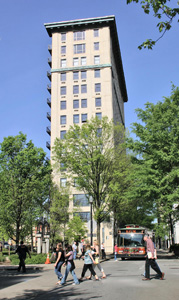Design Review Board Promotes Reinvestment in Downtown Knoxville

Take a walk along Gay Street in Downtown Knoxville, and you'll see entertainment destinations like Regal's Riviera Cinema, retail stores like Mast General Store, and residential properties such as The Holston. Stroll a little farther north, into the Old City, and notable stops include boutique retailers like Old City Cigar and specialty dining places such as The Crown and Goose. Each of these highlight a renewed interest and reinvestment in Knoxville's center city in the past decade. And these are only a sample of the many recent renovation and redevelopment success stories among high notes that include residential condominium projects, office properties, retail operations, and festival uses throughout Downtown and the Old City.
To help sustain reinvestment interest and to promote downtown as a viable place for a mix of commercial, office, civic, and residential uses, the Downtown Design Review Board (DDRB) was established in 2007. The DDRB reviews and approves plans for public and private improvements, applying development tools such as Design Guidelines and a Design Overlay District (the D-1 zoning district). The Board is comprised of nine voting members, tapped from various downtown stakeholder groups and appointed by City Council.
The Metropolitan Planning Commission provides staff support to the DDRB, processing project applications, drafting reports, preparing meeting agendas, and maintaining Board meeting minutes.
A major goal of the Design Review process is to create a pedestrian-friendly environment in the city center. To accomplish this, the Board looks to its Design Guidelines to measure whether a development proposal is appropriate. For instance, blank walls and ground-level, mirrored windows would be discouraged as they detract from a pleasant pedestrian experience. In general, any improvement to a building that is visible from the street and requires a building permit needs to be reviewed by the Design Board. Upon approval, a Certificate of Appropriateness is issued and construction can commence.
"The DDRB considers each application on its own merits. They generally approve a proposal if the project meets the intent of the guidelines and does not detract from the district as a whole," notes MPC planner and DDRB support staffer, Mike Reynolds.
Private improvement projects can range in scale from placement of signs and awnings, to renovations of entire historic structures, to the construction of new buildings. Public investments reviewed by the DDRB might include streetscape improvements and building construction. According to MPC's Reynolds, "recent approvals include signage improvements and exterior renovation for a proposed Urban Outfitters retail shop in the Arnstein Building, streetscape plans for Market Street and Union Avenue, and a major investment in exterior renovation and one-story addition at the Southeastern Glass building on Jackson Avenue at Broadway."
Not all projects require full board review. Some minor improvements, such as signs that meet guideline requirements or replacement of deteriorated features with replicated materials, can be approved by MPC staff. However, the majority of projects do require Board review.
The Downtown Design Review Board meets the third Wednesday of every month at 4 p.m. in the Small Assembly Room of the City County Building. Agendas are available online one week prior to each meeting. Additional Board documents also are available one theDDRB page of the MPC website.
For more information about the DDRB and the project review process, contact MPC's Mike Reynolds (mike.reynolds@knoxmpc.org) or Mike Carberry (mike.carberry@knoxmpc.org).
Posted 6-06-2012, written by MPC staff

